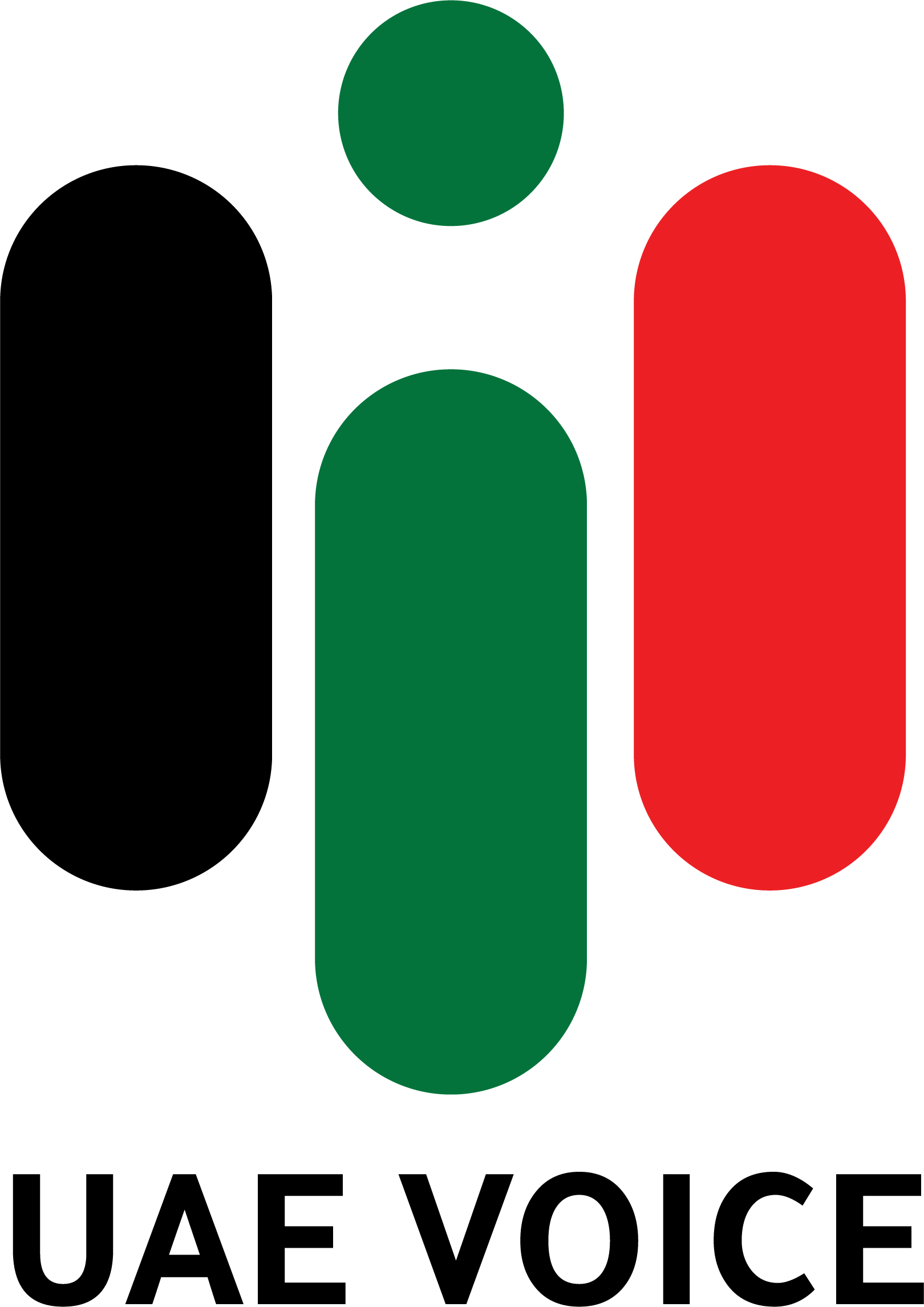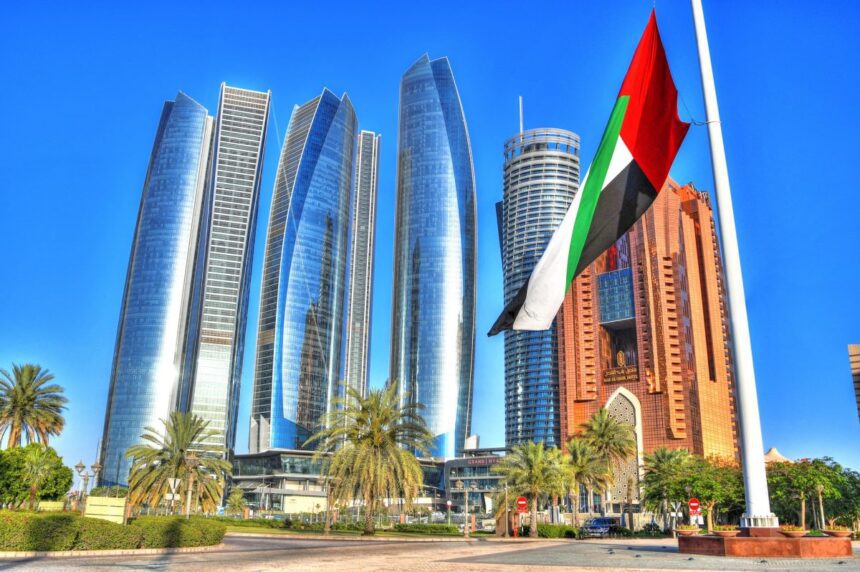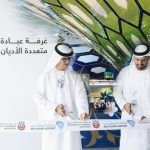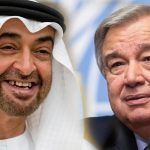Information About UAE You Probably Didn’t Know.
Through our article we will give you information about UAE in all fields.
The United Arab Emirates (UAE) location is in the Southeast of the Arabian Peninsula, bordering Oman and Saudi Arabia.
In December 1971, the UAE became a federation of six emirates: Abu Dhabi, Dubai, Sharjah, Ajman, Umm Al-Quwain, and Fujairah.
While the seventh emirate, Ras Al Khaimah, joined the federation in 1972.
The capital city is Abu Dhabi, located in the largest and wealthiest of the seven emirates.
Information About UAE history.
The UAE name was “Al Ghabraa” and then the Coast of Oman due to its connection to Oman.
Several groups such as Bani Yas were inhabiting the UAE.
Bani Yas: a group of people belongs to Al Yas Bin Amir composed of a tribal alliance; a policy by Arabs adopted to face hazards.
Descendants of Bani Yas include the families of Al Nahyan, Al Maktoum – Rulers of Abu Dhabi and Dubai.
As well as Al Qawassim, Rulers of Ras Al Khaimah and Sharjah.
Historic Events in the UAE.
- February 18th 1968: Al Samha meeting.
- July 18, 1971: The interim constitution of the UAE issued.
- December 2, 1971: The UAE was promulgated and the late Sheikh Zayed Bin Sultan Al Nahyan, then ruler of Abu Dhabi, was elected as the President.
The late Sheikh Rashid Bin Saeed Al Maktoum, then ruler of Dubai, elected as the Vice-President.
While the late Sheikh Maktoum Bin Rashid Bin Saeed Al Maktoum was the Prime Minister. - December 6, 1971: The UAE joined the League of Arab States.
- December 23, 1971: Ras Al Khaimah sent a message to the Supreme Council to join the federation.
- February 12, 1975: the establishment of The National Federal Council.
- December 13, 1972: The first session of the National Federal Council.
- May 1981: The UAE hosted the first Gulf summit.
Since its Federation in 1971, the UAE has developed rapidly and in 2021, the UAE commemorated its Golden Jubilee, 50 years since federation.
The UAE will host the COP28 international climate summit in Dubai this year.
Interesting Information About UAE Population.
In 1950, the population of the UAE was just 70,000.
But with the discovery of oil in the late 1950s a huge economic and social transformation began.
As infrastructural activities began in full swing, the need for foreign labor increased.
Since then, the UAE has seen a huge number of people trickling in to gain from the profitable economic bustle.
Including trade, real estate, construction etc.
By 2023 the population of the UAE is 10.17 Million.
The UAE Rulers & Ruling System.
The President of the UAE: (HH) Sheikh Mohammed bin Zayed Al Nahyan.
The Ruler of Dubai: HH Sheikh Mohammed bin Rashid Al Maktoum, is the Vice-President, Prime Minister and Defence Minister.
The UAE’s federal structure includes a Supreme Council (comprising the Rulers of each Emirate), a Council of Ministers and Federal National Council.
Each Emirate has its own governing Ruler, besides its own local government, courts and police forces.
The Federal National Council comprises 40 members, half of members appointed and half elected.
The last elections were in October 2019 and for the first time the UAE implemented a requirement for 50 per cent of total members to be women.
You can read: Meet the UAE Founder “Sheikh Zayed” & Know His Achievements.
The UAE economy is the second-largest economy in the Arab world (after Saudi Arabia).
Which is the most incredible information about UAE Economy.
Which is the most incredible information about UAE Economy.
The UAE has an open mixed free-market economy based mainly on oil and natural gas production.
Economic diversification has reduced the oil and gas sector’s share of the country’s GDP to 30 %.
Additionally, the country’s free trade zones attract foreign investors by offering 100% foreign ownership and almost zero taxes.
A five-percent value-added tax implemented since January 2018.
Major UAE Companies
Abu Dhabi National Oil Company (ADNOC): the state-owned oil company of the UAE.
Abu Dhabi Commercial Bank ADCB:the third-largest bank in the UAE.
Emirates NBD: One of the largest banking groups in the Middle East is Dubai government-owned.
Dubai Islamic Bank: the largest Islamic bank in the UAE.
First Abu Dhabi Bank FAB: the largest bank in the United Arab Emirates.
Mashreq: the oldest privately owned bank in the UAE, founded as the Bank of Oman in 1967; it was the first bank in the Emirates to install ATMs.
Emaar Properties: a multinational real estate company, which operates project development and its project marketing in Dubai.
Etisalat: a multinational, Emirati based telecommunications services provider.
The Emirates Group: The state-owned international aviation holding company based in Dubai offers ground handling services and operates Emirates Airlines.
Which is the largest airline in the Middle East.
DP World: Based in Dubai, DP World is one of the world’s largest port operators and operates 78 terminals in various countries.
Mentioning that the UAE companies are dominating Forbes list.
To celebrate 50 years of nationhood in 2021, the UAE launched 50 new economic initiatives to boost the country’s competitiveness.
And also to attract US$150 billion in foreign direct investment over the next nine years.
And also to attract US$150 billion in foreign direct investment over the next nine years.
Abu Dhabi, which has the vast majority of oil and gas reserves in the UAE, has made significant investments in the establishment of the following:
–Aerospace.
-Nuclear power.
-Defence.
-Information technology (micro-processing).
-Petrochemical.
–Clean-tech industries.
The latter most prominently represented by the multibillion-dollar initiative of Masdar City, a zero-carbon city outside Abu Dhabi.
Abu Dhabi is also investing heavily in educational institutions and cultural attractions.
In addition to sporting attractions such as the Formula One racing track, Ferrari theme park.
As well as the Louvre Abu Dhabi to diversify the economy away from oil and encourage tourism.
Surely you need to know information about UAE Resources and power, especially the oil which has mainly built the UAE economy.
Abu Dhabi discovered oil by 1958.
Moreover, the government of Abu Dhabi owns a controlling interest in all oil-producing companies through the Abu Dhabi National Oil Company (ADNOC).
Abu Dhabi is responsible for about 95 percent of the country’s oil production,
While petroleum production in Dubai began in 1969.
There are offshore oil fields at Ḥaql Fatḥ, Fallah, and Rāshid.
Dubai emirate long maintained a controlling interest in its oil fields and took full control of oil production in 2007.
However, oil Production dwindled to a negligible amount as the emirate diversified its economy.
Sharjah began producing oil in 1974; another field, predominantly yielding natural gas discovered six years later.
In 1984 oil production began off the shore of Ras al-Khaimah, in the Persian Gulf.
The federation’s natural gas reserves are among the world’s largest, and most fields are found in Abu Dhabi.
In the late 1990s the UAE began investing heavily to develop its natural gas sector.
In the late 1990s the UAE began investing heavily to develop its natural gas sector.
Because it relies on energy-intensive technologies such as water desalination and air-conditioning.
and because subsidies on fuel have encouraged wasteful energy use, the United Arab Emirates has one of the world’s highest per capita rates of energy consumption.
To safeguard future hydrocarbon production, the federation began to explore other sources for domestic energy.
In 2009 the UAE contracted the Korean Electric Power Company to build four nuclear reactors in the country by 2020.
Abu Dhabi and Dubai also began to invest in renewable energy.
In 2013 Abu Dhabi opened what, at the time, was one of the world’s largest solar power plants, a 100-megawatt facility capable of powering up to 20,000 homes
Manufacturing in the UAE.
From the previous information about UAE we learnt that UAE has attempted to diversify the economy to avoid complete dependence on oil.
Due to that, manufacturing has played a significant part in that effort.
A petrochemical industrial complex has been established at Al-Ruways.
Al Ruways is 140 miles (225 km) southwest of Abu Dhabi city, with a petroleum refinery, a gas fractionation plant, and an ammonia and urea plant.
Dubai’s revenues have been invested in projects such as a dry dock and a trade centre; its first airport was expanded in the 2000s.
A second airport was built near the port of Jebel Ali.
Also, many hotels are in Dubai, including the striking Burj al-ʿArab (“Tower of the Arabs”), which opened in the late 1990s.
The Burj Khalifa (“Khalifa Tower”) skyscraper in Dubai city became the world’s tallest building and the tallest freestanding structure when it opened in 2010.
Sharjah has built a cement plant, a plastic-pipe factory, and paint factories. Manufacturing accounts for less than one-tenth of GDP in the country overall.
Finance and trade of the United Arab Emirates
In 1980 Dubai and Abu Dhabi established the Central Bank of the UAE, each emirate deposited half of its revenues in the institution.
The bank also issues the UAE dirham, the emirates’ national currency.
In the 1990s, Abu Dhabi emirate created the Abu Dhabi Free Zone Authority to develop a new financial center.
The UAE’s first official stock exchange, Dubai Financial Market (Sūq Dubayy al-Mālī; DFM), was opened in 2000.
Also, Dubai International Financial Exchange opening was in 2005.
The United Arab Emirates is a leading force in the development of modern Islamic finance, financial practices that comply with Sharīʿah laws of transaction.
The world’s first commercial Islamic bank is Dubai Islamic Bank (DIB).
In 2007 the DFM became the first stock exchange to comply with the standards of Islamic finance.
Because the United Arab Emirates is an international financial and commercial hub, its Islamic financial institutions have become a particularly attractive market for Islamic organizations worldwide.
Trade has long been important to Dubai and Sharjah.
Even before the discovery of oil, Dubai’s prosperity was assured by its role as the Persian Gulf’s leading entrepôt.
Even before the discovery of oil, Dubai’s prosperity was assured by its role as the Persian Gulf’s leading entrepôt.
In 1995 the UAE joined the World Trade Organization and since then has developed a number of free-trade zones.
In addition to technology parks, and modern ports in order to attract trade.
In addition to technology parks, and modern ports in order to attract trade.
The large free-trade zone of Port Jebel Ali developed during the 1980s.
Which has done much to attract foreign manufacturing industries interested in producing goods for export.
In fact, exports are dominated by petroleum and natural gas.
While imports consist primarily of machinery and transport equipment, gold, precious stones, and foods.
Major trading partners include China, India, Japan, and western European countries. A large amount of trade is in re-exports to neighboring gulf countries.
Information about UAE Transportation and telecommunications
An excellent road system, developed in the late 1960s and ’70s, carries motor vehicles throughout the country and links it to its neighbors.
The addition of a tunnel to the bridges connecting Dubai city and the nearby commercial center of Dayrah facilitates the movement of traffic across the small saltwater inlet that separates them.
The main important information about UAE transport is that most of the UAE emirates are served by international airports.
Including: Abu Dhabi, Dubai, Sharjah, Ras al-Khaimah, Fujairah, and Al-Ain.
Read about Abu Dhabi New Terminal: Tom Cruise among the first visitors to Abu Dhabi New Terminal.
A second airport opened to serve Dubai in 2010.
The older airport at Dubai is one of the busiest in the Middle East.
The UAE has a number of large and modern seaports, including the facilities at Dubai’s Port Rāshid, and Port Jebel Ali.
Situated in one of the largest harbors in the world and one of the busiest ports in the gulf.
Sharjah has a modest port north of the city.
In September 2009 the first portion of a remote-controlled rapid-transit metro line—the Gulf region’s first metro system—began operations in Dubai.
Additional public transit projects, including monorail service in Abu Dhabi and linkages to the Saudi rail networks, have been planned as well.
Construction of a railway connecting all seven emirates began in 2012; the section between Abu Dhabi and Dubai was completed in 2022.
A planned Hyperloop system will connect Abu Dhabi and Dubai soon.
Etisalat (Ittiṣālāt) controlled Emirates Telecommunications Corporation is a major telecommunications provider in the UAE.
Radio, television, telephone, and cellular telephone service is prevalent and widely used.
In 2000 Etisalat began providing Internet service, and the emirates soon had one of the largest subscriber bases per capita in the Middle East.
By 2005 a second licensed operator, Emirates Integrated Telecommunications Company (du), began providing telephone and high-speed Internet service.
In 2006 they reached an agreement with Etisalat to link their networks.
Information about UAE Education You need to know in case you have children.
Education in the emirates is free and mandatory at the primary and secondary levels for all children from age 6 to 18.
There are a number of fine institutions of higher education in the UAE, and kids attend public school.
Moreover, female students far outnumber males at the United Arab Emirates University, which opened at Al-Ain in 1977.
And also at the Higher Colleges of Technology system (1988) throughout the emirates.
Zayed University (1998) was established to provide women with technical education, though in 2008 it began admitting men as well.
Overall, women make up approximately 70 percent of university graduates at Emirati universities.
Although men are much more likely than women to go abroad for university study. By the 2010s the vast majority of the population was literate.
The cultural traditions of the United Arab Emirates are rooted in Islam and resonate with the wider Arab world.
Especially with the neighboring states of the Persian Gulf.
The federation has experienced the impact of Islamic resurgence.
Also, tribal identities in the UAE remain fairly strong, despite urbanization and the presence of a large expatriate community.
While the most important information about UAE culture is: the family is still considered the strongest and most cohesive social unit.
Detailed information about UAE cuisine whichreflects the variety of cultural influences that the UAE has experienced over the centuries.
Hummus, fūl (spiced bean paste), falafel, and shawarma (broiled meat served on flatbread) are dishes standard to the Arab world.
Whereas the influence of Iranian cuisine can be seen in the Emirati preference for rice as a staple and ingredients such as saffron, cardamom.
In addition to rose water as flavoring in desserts.
Among the favorite dishes is makbūs—poultry, meat, or fish atop a bed of rice spiced with seasonings and dried lime.
As in all countries of the region, lamb and chicken are the preferred meats.
While fresh fruits—including dates, figs, lemons, and limes—and vegetables and flatbread (khubz) are daily fare.
The most preferable drink is coffee, served in the popular fashion—hot, strong, and sweet.
Information about UAE Arts and Cultural institutions
As is true of other countries of the Arabian Peninsula, traditional arts such as pottery, weaving, and metalworking occupy a prominent place in cultural life.
The manufacture of handicrafts is an economic mainstay for smaller villages.
Since they are providing goods to sell in the souks (open-air markets) that lie at the heart of small towns and large cities alike.
Traditional storytelling remains a much-admired art form, and Emirati culture, like Arab culture on the whole, esteems poetry.
Whether it is classical, contemporary, or the Bedouin vernacular form called nabaṭī.
Traditional music, such as the ḥudāʾ—sung originally by caravanners while on the trail—is enjoyed alongside popular music from abroad.
Also the traditional dances such as the ʿayyālah (often called ʿarḍah), a type of sword dance, are performed on special occasions.
Annually, the Ministry of Information and Culture sponsors a number of events.
Including plays and music festivals, and helps support the numerous folklore associations in the emirates.
When it comes to cultural institutions, we should mention the Museum of the Future first.
As well as Dubai Museum which is located in al-Fahīdī Fort and features displays on Bedouin life, local history, dances, and musical instruments.
The fort is also home to a military museum. Al-Ain is the site of a museum devoted to Bedouin culture and the emirates’ pre-oil history.
Sharjah city features a noted natural history museum.
Dubai city is growing as a center for regional film, television, and music production.
In addition to the Dubai Opera House.
Abu Dhabi hosts the Louvre Abu Dhabi, a museum that leases its name, collection, and expertise from the Louvre in Paris.
Sports are popular in the UAE as the government really supports them.
The Ministry of Youth and Sports oversees and encourages the many groups, clubs, and associations that provide sports-related activities.
From the information about UAE is that Football (soccer) is the most-watched spectator sport.
Also horse racing enjoys widespread popularity
The UAE is also a major center for camel racing, a traditional sport that became increasingly popular late in the 20th century.
As well as falconry, once an important means of hunting.
Jujitsu became popular and widespread in the 21st century, especially because of the patronage of Abu Dhabi’s ruling Nahyan family.
The country hosts many international sports events, most notably for golf, jujitsu, tennis, rugby, and boat racing.
The UAE made its Olympic debut at the 1984 Summer Games, and its national football (soccer) team qualified for the World Cup in 1990.
Furthermore, Abu Dhabi began hosting the final Grand Prix of the Formula One World Championship tournament in 2009.
The UAE hosted the FIFA Club World Cup in 2018, in which the club from Al-Ain played Real Madrid in the final match, and hosted the Asian Cup tournament months later in 2019.
Read More:
Emirates Airline Cabin Crew Number Exceeds 20,000
UAE Central Bank Revoked Licenses Of 2 Exchange Companies.





